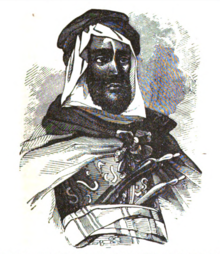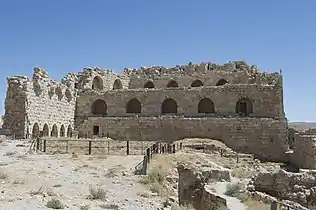Al-Fayez
The House of Fayez (Arabic: الفايز or, colloquially: Al-Fayez, Alfayez, Al Fayez, Al Faiz, Al Fayiz) is a Jordanian political family that heads the major Jordanian clan Bani Sakher. The family's influence and prominence in the region was at its ultimate under Fendi Al-Fayez who led the family in the 1850s and gradually became the leader of the entire Bani Sakher.[1] His young son Sattam led the tribe in a push to cultivate the lands and live a more sedentary life style, then under Mithqal Alfayez as a permanent political power in modern Jordan.[2] The family used to be the largest owner of land in Jordan and owned portions of modern day Palestine, and Mithqal was the single largest owner of private land in the kingdom in 1922.[3]
| House of ِFayez الفايز | |
|---|---|
| Bani Sakher | |
| Parent house | Bani Sakher of Banu Tayy |
| Country | |
| Etymology | Fayez Al-Tayy, considered the founder of the house |
| Place of origin | Arabia |
| Founded | c. 1675 |
| Founder | Fayez Al-Tayy |
| Current head | Faisal Al-Fayez |
| Titles | Conferred by the House of Osman:
Conferred by the House of Hashim:
|
History
The Al-Fayez family came from the Bani Sakher tribe that originated from the Arabian Banu Tayy Tribe which itself originated from the Qahtanites in Yemen, and the Bani Sakher were first mentioned in text in the 15th century AD[4].The origin of the name is from the progenitor of the house, Fayez bin Fadel Al-Tayy. Fayez is derived from the Arabic word Fa'iz, meaning "Winner" in Arabic. The Bani Sakher Tribe was separated from Banu Tayy during that time as they migrated north to modern day Jordan, and then the Fayez were further distinguished after multiple successful leaders from the family and furthermore the lineage of Fayez Al-Tayy.

The family was briefly split between in 1879 when Sheikh Fendi died of illness on his way back from Nablus. During that time, half of his eight remaining sons allied with the Adwan who were Bani Sakher's adversaries, and the other half under Sheikh Satm allied with the Anazah tribe. in May of 1881 Sheikh Satm was killed in a skirmish with the Adwan, this likely gave the opportunity to Sheikh Sattam to reunite the tribe in September, 1881, to regain the influence that his father had on the area.[5] However those two years would prove to be a big loss for the Fayez family as they never recovered to the peak that they experienced under Fendi.
18th Century
In 1742, Sheikh Qa'dan Al-Fayez, the progenitor of the Qa'dan branch of the Al-Fayez family and the grandson of Fayez Al-Tay, was invited to support the Ottoman state in Sieging Tiberias. Although the siege was a failure, the Beni Sakher was still thanked by an invite from As'ad Pasha al-Azm to escort the Hajj Caravans. In 1757, the Ottoman state failed to pay the Beni Sakher for their services, this coupled with the drought of 1756 has led to the infamous raid in 1757 led by Qa'dan. The raid's casualties was in the tens of thousands, including Musa Pasha and the sister of the sultan.[6]

19th Century
In 1820, Fendi Al-Fayez led in battle for the first recorded time, and by mid century he was the paramount sheikh and revered throughout Arabia.

One of the most famous conflicts that they had was against the Mejalli in 1863 and was documented by the Italian explorer Carlo Claudio Camillo Guarmani in his book that Northern Nejd. that the Al Tafilah villagers, who were subject to Mohammad Al-Majalli, paying yearly tributes to him, were discontented with the recent negligence of the Majalis in protecting the villagers. The Tafilah chief were gathered by Abdullah Al-Huara, the chief of the Tafilah, and agreed to renounce vassalage and replace the tribute with an annual gift as a homage instead. Al-Majalli was discontent with this, and was ready to force the Tafilah's to become their vassals again, but was stopped by the Bani Sakher headed by Fendi, where Fendi sent Shleesh Al-Bakhit Al-Fayez to ensure the contract between them where both parties comprised to avoid bloodshed.
However, January, 1864, Al-Majalli again decided to attack and announce himself the master of the Tafilah, and was met with an immediate declaration of war from Fendi himself. Shleesh Al-Bakhit was successful in leading an attack against Qoblan Al-Mkheisen who was appointed by Al-Majalli to oversee the Tafilah. Fendi shortly after sent 200 who met a force of 2000 riflemen on dromedaries. During the long standstill, the people of Al-Kerak were virtually under siege and were quickly running out of food and becoming increasingly ill-content, sensing this, Al-Majalli secretly went to Fendi in the night to personally declare his surrender to him and agreed to pay reparations to all those wronged in the conflict, including reinstating Al-Huara's son as the Chief of Al-Tafilah.[7]

20th Century
in 1923, during the Adwan rebellion, Mithqal Al-Fayez led the Beni Sakher against the Adwan and in full support of Emir Abdullah, with the result being the defeat of the Adwan forces with some taken as prisoners and exiled.
21st Century - present
In 2004, Faisal Al-Fayez became Prime Minister of Jordan.
In 2018, a member of the Al-Fayez family, Zaid Mohammad Sami Al-Fayez, was attacked in public by Emad Shawabkeh and 7 other assailants. The conflict was solved by tribal leaders from both sides and the assailants are in police custody.[8]
Heads of the House
The Al-Fayez have customarily choose a head of the house (Sheikh), usually conforming to the Bedouin custom of conferring the role to the eldest son (Albikir) of the current head, however throughout its long history there were some exceptions to this tradition. Note that the head of the Al-Fayez, would also be the head or co-head (with the head of the House of Khraisha) of the Bani Sakher clan as the Al-Fayez are the leading house in the clan.
| Name | Title(s) | From | Until | Relationship with predecessor | |
|---|---|---|---|---|---|
| 1st | ِAbbas Al-Fayez | c1810 | c1835 | Son of Salameh Al-Fayez, who is the great grandson of the progenitor Fayez Al-Tayy | |
| 2nd | Fendi Al-Fayez | c1840s | 1879 | Son of Abbas Al-Fayez | |
| 3rd | Satm Al-Fayez | 1879 | May,1881 | Son of Fendi Al-Fayez | |
| 4th | Sattam Al-Fayez | September,1881 | 1890 | Youngest brother of Satm Al-Fayez | |
| 5th | Talal Al-Fayez | 1890 | 1909 | Brother of Sattam Al-Fayez | |
| 6th | Fawaz Al-Fayez | 1909 | 1917 | Nephew of Talal Al-Fayez, son of Sattam Al-Fayez | |
| 7th | Mashour Al-Fayez | 1917 | 30 April 1921 | Son of Fawaz Al-Fayez | |
| 8th | Mithqal Al-Fayez | 31 April 1921 | 15 April 1967 | Mashour's Cousin, Son of Sattam Al-Fayez | |
| 9th | Akef Al-Fayez |
|
16 April 1967 | 8 April 1998 | Son of Mithqal Al-Fayez |
| 10th | Sami Al-Fayez | 16 April 1998 | 19 November 2012 | Brother of Akef Al-Fayez | |
| 11th | Faisal Al-Fayez |
|
20 November 2012 | present | Sami Al-Fayez's nephew and son of Akef Al-Fayez |
Notable Figures
18th Century:
- Abbas Al-Fayez
- Qa'dan Al-Fayez
19th Century:
- Fendi Al-Fayez
- Suleiman Al-Fayez[12]
- Sattam Al-Fayez (Emir and Tribal Chief)
- Nawaf Fendi Al-Fayez (Emir)
- Satm Fendi Al-Fayez (Tribal Chief)
- Sahan Fendi Al-Fayez (Judge)
- Eid Suleiman Al-Fayez
- Shleish Al Bakhit Al-Fayez
20th Century:
- Mithqal Al Fayez (Tribal Chief, Politician, Commander-In-Fighting)[13]
- Talal Fendi Al-Fayez (Beylerbey and Tribal Chief)
- Akef Al-Fayez (Tribal Chief and politician)
- Zaid Mithqal Al-Fayez (Senior Officer at the Prime Ministry)
- Fawaz Sattam Al-Fayez (Tribal Chief)
- Mashour Fawaz Al-Fayez (Tribal Chief)
20th Century - present:
- Faisal Al-Fayez (Prime Minister)
- Amer Al-Fayez (Chairman of Al-Abdali, Chief of Royal Protocol, Ministerial rank)[14]
- Trad Al-Fayez (Minister of Agriculture, Ambassador, Senator)
- Tayil Al-Fayez (President of the Jordanian Olympic Club)
- Sami Al-Fayez (Tribal Chief and Senator)
- Eid Al-Fayez (Minister of Interior, State, and Labor)
- Nayef Al-Fayez (Minister of Tourism)
- Nayef Hayel Al-Fayez (Minister of Health, MP)
- Alanoud Al-Fayez (ex-wife of King ِAbdulaziz)
- Hakem Al-Fayez (Politician)
- Hind Al-Fayez (MP)
- Muhammad Al-Fayez (MP)
- Habis Sami Al-Fayez (MP)
- Bassam Al-Fayez (MP)
References
- Alon, Yoav (2016). The Shaykh of Shaykhs: Mithqal al-Fayiz and Tribal Leadership in Modern Jordan. Stanford University Press. pp. 8–11. ISBN 9780804799348.
- Alon, Yoav. The Shaykh of Shaykhs: Mithqal Al-Fayiz and Tribal Leadership in Modern Jordan. Stanford University Press, 2016.
- Warriner, Land Reform, p.160.
- Peake, Pasha. A History of Jordan and Its Tribes. University of Miami Press, 1958.
- Conder, C.R. Conder (1889). The Survey of Eastern Palestine. London: The Committee of the Palestine Exploration Fund. p. 295.
- Barbir, Karl (1980). Ottoman Rule in Damascus, 1708-1757. Princeton, New Jersey: Princeton University Press. pp. 175–178.
- Guarmani, Carlo (1938). Northern Najd. London, England: The Argonaut Press. pp. 109–110.
- "Unrest in Madaba over Fayez Youth Assault Contained". Al Ghad. May 8, 2018.
- Tristam, Henry Baker (1873). The Land of Moab. London, Murray, Albemarle Street: Cambridge University Press. p. 227. ISBN 9781108042062.
- Fish, Henry C. (1876). Bible Lands Illustrated. Columbia University: American Publishing Company. p. 305.
- Abu Jaber, Rauf (1989). Pioneers Over Jordan. Bloomsbury Academic. ISBN 1850431167.
- Layard, Austen Henry (1887). Early adventures in Persia, Susiana, and Babylonia. London.
- "Sheikh Mithqal Al Fayez". Arab Revolt. Retrieved 12 December 2020.
- "Royal Decree gives Al Fayez rank of minister". Ammon News. 3 December 2009.
